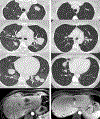Adoptive T-Cell Therapy for Cancer
- PMID: 26923004
- PMCID: PMC6293459
- DOI: 10.1016/bs.ai.2015.12.006
Adoptive T-Cell Therapy for Cancer
Abstract
Recent developments have demonstrated that immunotherapies are capable of achieving durable antitumor responses in patients with metastatic cancer. One modality that has been able to induce durable complete regressions in patients with melanoma has been adoptive cell therapy (ACT). This has slowly been expanded to other cancer types using new approaches such as genetically engineered T-cells and other methods of antigen targeting. It now appears that immune targeting of mutated "neoantigens" plays a major role in successful ACT, as well as in other immunotherapies such as checkpoint inhibitors. This realization presents not only new challenges to ACT but also new opportunities in that all tumors now may have potential antigens to attack that can be revealed by tumor genomic sequencing. There are a variety of exciting approaches to translate these new findings into clinical trials applying ACT to the majority of cancer types.
Keywords: Adoptive cell therapy; Immunotherapy; Neoantigens; T-cell transfer; Tumor antigens; Tumor infiltrating lymphocytes.
2016 Published by Elsevier Inc.
Figures


References
-
- American Association for Cancer Research. (2015). Expanding the reach of anti-PD-1 therapy. Cancer Discovery, 5, 684–685. - PubMed
-
- Boon T, Cerottini JC, Van den Eynde B, van der Bruggen P, & Van PA (1994). Tumor antigens recognized by T lymphocytes. Annual Review of Immunology, 12, 337–365. - PubMed
-
- Brentjens RJ, Santos E, Nikhamin Y, Yeh R, Matsushita M, La PK, et al. (2007). Genetically targeted T cells eradicate systemic acute lymphoblastic leukemia xenografts. Clinical Cancer Research, 13, 5426–5435. - PubMed
-
- Bronte V, & Mocellin S (2009). Suppressive influences in the immune response to cancer.Journal of Immunotherapy, 32, 1–11. - PubMed
Publication types
MeSH terms
Substances
Grants and funding
LinkOut - more resources
Full Text Sources
Other Literature Sources

